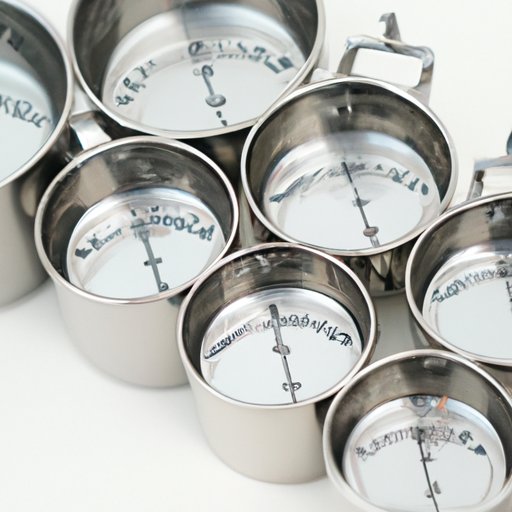Introduction
Cooking can be a fun and creative process, but it can also be stressful and confusing, especially when it comes to converting pounds to cups. Most recipes use either cups or pounds to measure ingredients, and while cups are a common measuring tool, pounds are often used for bulkier ingredients. Home cooks may find it challenging to calculate the correct conversion between the two measurement units, resulting in inaccurate measurements and a failed recipe. This article provides a simple guide for converting pounds to cups to make cooking a more enjoyable and successful experience.
A Simple Guide to Converting Pounds to Cups
Before diving into the conversion process, let’s define what a pound and a cup measure. A pound is a weight measurement equivalent to 16 ounces, while a cup is a volume measurement that varies depending on the ingredient being measured. For example, a cup of flour and a cup of sugar have different weights, so they will not convert to the same number of cups.
To simplify the conversion process, we have compiled a conversion table for some commonly used ingredients:
| Ingredient | 1 Pound Equals | Cups |
|---|---|---|
| All-purpose Flour | 16 ounces | 3.5 cups |
| Granulated Sugar | 16 ounces | 2 cups |
| Brown Sugar | 16 ounces | 2.5 cups (packed) |
| Butter | 16 ounces | 2 cups (4 sticks) |
It is essential to measure ingredients accurately when cooking, so here are some tips to ensure precise measurements:
- Use dry measuring cups for dry ingredients and liquid measuring cups for liquid ingredients.
- Spoon dry ingredients into the measuring cup and level off with a straight edge to avoid packing them too tightly.
- When measuring liquid ingredients, place the measuring cup on a flat surface and adjust the level by looking at it from the side.
- For butter, use the measurement markings on the butter wrapper or cut the butter into tablespoon slices and measure accordingly.
How to Measure Ingredients in Cooking: Decoding Cups and Pounds
Accurate measurement of ingredients is essential to achieve the right taste, texture, and consistency in a recipe. In cooking, different measurement units are used, including cups, ounces, tablespoons, teaspoons, and pounds. These units often vary depending on the ingredient being measured.
Using volume measurements such as cups is quick and convenient for measuring liquid and dry ingredients such as sugar, flour, and salt, but these measurements can be unreliable for denser ingredients like butter and chocolate chips. In contrast, measuring by weight, such as ounces and pounds, is more accurate and consistent.
When measuring ingredients using cups and pounds, it is important to follow these guidelines:
- Use graduated measuring cups, which provide a precise unit of measurement.
- When measuring dry ingredients, spoon the ingredient into the measuring cup and level off with a straight edge for accurate measurement.
- When measuring liquid ingredients, place the measuring cup on a flat surface and adjust the level visually to get an accurate measurement.
- For accurate weight measurements, use a digital scale calibrated in ounces or grams.
- Ensure that the scale is on a stable surface to obtain exact measurements.
The Relationship Between Pounds and Cups: Understanding Measurements in the Kitchen
As we mentioned earlier, pounds and cups measure different things, and measurements by volumes can lead to discrepancies, making measuring by weight a more accurate method. Measuring by weight is especially crucial when baking, where precise measurements can make or break a recipe.
For example, one cup of flour measures differently when scooped, spooned, or sifted, resulting in different weights. Similarly, brown sugar packed tightly will have a different weight than brown sugar that is loosely packed.
When measuring by weight, the weight of an ingredient remains constant, regardless of its volume. Thus, it is crucial to understand the relationship between pounds and cups.
Cooking Measurement Conversions: From Pounds to Cups
There are different ways to convert pounds to cups for cooking, including using a conversion chart or calculator, simple arithmetic calculations, and using an app or tool.
To convert pounds to cups using the arithmetic method, use the following formula:
Cups = Pounds x Cup Measurement of Ingredient
For example, to convert 2 pounds of sugar to cups, we use the formula:
2 pounds x 2 cups = 4 cups
There are also many measurement conversion tools and apps available online; some of these free apps even provide conversions for international measurement units.
How Many Cups are in One Pound: A Useful Guide for Every Home Cook
Here are the conversion ratios for some common ingredients from pounds to cups:
- All-purpose Flour: 1 pound = 3.5 cups
- Granulated Sugar: 1 pound = 2 cups
- Brown Sugar: 1 pound = 2.5 cups packed
- Butter: 1 pound = 2 cups (4 sticks)
However, it is important to consider that not all ingredients measure the same in cups per pound. For some bulkier ingredients, such as oats or chocolate chips, the cup per pound ratio varies.
Measuring ingredients accurately reassures the best results when cooking. Use the tips outlined in this article to ensure accurate measurement to achieve the right taste, texture, and consistency for your recipe.
Conclusion
Converting pounds to cups can seem complicated at first, but with practice and the right tools, it can become easy. Accurate measurement of ingredients is crucial to achieve good results. We urge home cooks to use these tips, techniques, and tools to make their cooking experience more successful and hassle-free.
Remember to use the conversion chart, application, or formula from this article, and measure ingredients accurately. Testing and trial can be fun, but always remember to take care of the measurement to achieve success in your recipe every time.
